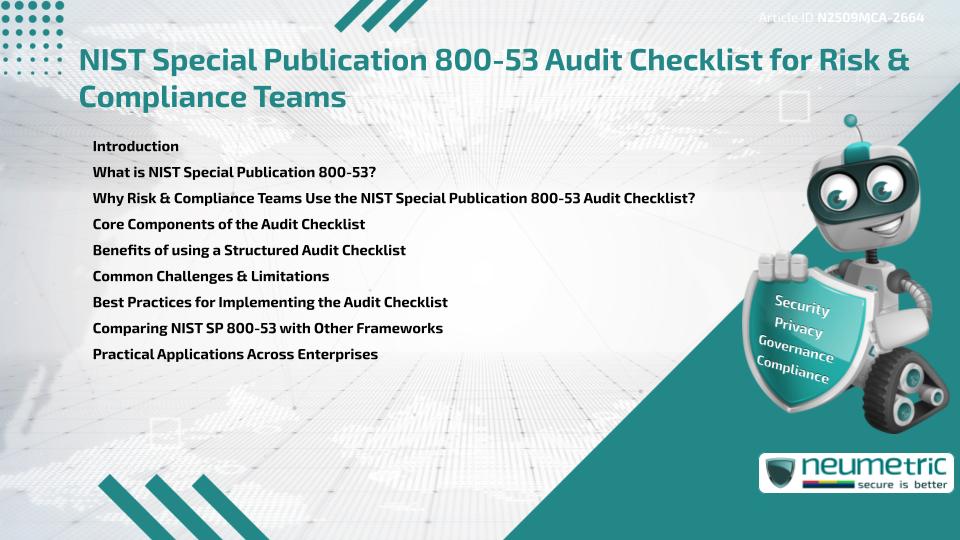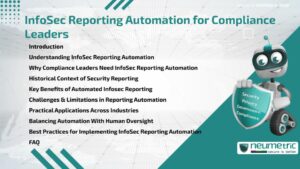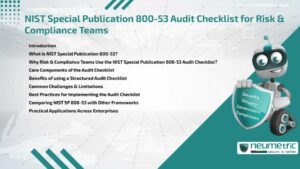Table of Contents
ToggleIntroduction
Risk & Compliance teams face increasing pressure to secure systems & prove adherence to Regulatory Standards. The NIST Special Publication 800-53 Audit Checklist provides a comprehensive Framework to guide Organisations through evaluating & strengthening their security posture. This article explains what NIST SP 800-53 is, why enterprises rely on its Audit Checklist, the key components involved, benefits & challenges & how teams can apply it across industries to ensure Compliance & manage Risks effectively.
What is NIST Special Publication 800-53?
NIST Special Publication 800-53, developed by the National Institute of Standards & Technology, outlines Security & Privacy controls for Federal Information Systems. It is widely adopted across industries due to its rigorous approach to safeguarding Sensitive Data. The NIST Special Publication 800-53 Audit Checklist translates these controls into actionable steps that Organisations can use to assess whether they meet required standards.
Why Risk & Compliance Teams Use the NIST Special Publication 800-53 Audit Checklist?
Compliance teams use the NIST Special Publication 800-53 Audit Checklist to systematically review Security Controls, identify Gaps & prepare for Internal or External Audits. It acts like a roadmap, guiding Organisations through hundreds of control families that cover Access, Risk Assessment, Incident Response & Privacy protections. According to NIST, the Framework is designed to support consistency across federal & non-federal systems, ensuring uniform protection of Sensitive Data.
Core Components of the Audit Checklist
The NIST Special Publication 800-53 Audit Checklist is divided into control families such as:
- Access Control – managing who can access Systems & Data.
- Audit & accountability – maintaining logs & monitoring activity.
- Configuration management – standardising & securing system settings.
- Incident Response – preparing & reacting to Security Incidents.
- Risk Assessment – identifying & addressing Vulnerabilities.
- System & communications protection – safeguarding information flow.
Each control area provides a Checklist item that helps teams assess Compliance with established standards.
Benefits of using a Structured Audit Checklist
Organisations that rely on the NIST Special Publication 800-53 Audit Checklist gain several advantages:
- Consistent evaluation of Security Controls.
- Easier preparation for Audits & Certifications.
- Improved detection of weaknesses before they cause breaches.
- Alignment with federal standards, which boosts Trust with Stakeholders.
- Greater clarity in roles & responsibilities within Compliance teams.
Common Challenges & Limitations
Despite its benefits, implementing the NIST Special Publication 800-53 Audit Checklist can be challenging. The Framework is extensive & requires significant time & expertise to interpret. Smaller enterprises may find it resource-intensive. Additionally, overreliance on the Checklist may lead to a “check-the-box” mindset, where Compliance is prioritised over true security improvement.
Best Practices for Implementing the Audit Checklist
To maximise value from the NIST Special Publication 800-53 Audit Checklist, teams should:
- Tailor the Checklist to organisational Risk & Operational needs.
- Use automation tools for Continuous Monitoring & Reporting.
- Train staff regularly to understand Control requirements.
- Integrate the Checklist into daily operations, not just Audits.
- Periodically review updates to NIST SP 800-53 to stay current.
Comparing NIST SP 800-53 with Other Frameworks
While frameworks like ISO 27001 & CIS Controls provide security guidelines, NIST SP 800-53 is broader & more detailed. The NIST Special Publication 800-53 Audit Checklist covers Privacy, Risk Management & Technical controls in more depth. For example, CIS offers prioritised controls but does not match the extensive catalog found in NIST publications. This makes NIST SP 800-53 especially valuable for enterprises seeking thorough coverage.
Practical Applications Across Enterprises
Although originally intended for federal systems, the NIST Special Publication 800-53 Audit Checklist is now widely applied in industries such as Healthcare, Banking & Technology.
Takeaways
- Provides a structured approach for Risk & Compliance evaluations.
- Improves Audit readiness & Stakeholder Trust.
- Covers a wide range of control families, from access to Incident Response.
- Can be resource-intensive for smaller Organisations.
- Works best when integrated into daily operations, not just Audits.
FAQ
What is the purpose of the NIST Special Publication 800-53 Audit Checklist?
It helps Organisations evaluate & strengthen Security & Privacy controls in line with NIST standards.
Who uses the NIST Special Publication 800-53 Audit Checklist?
Risk & Compliance teams, Auditors & Security Professionals across federal & non-federal industries use it.
How often should the Checklist be applied?
Ideally, it should be applied continuously with periodic Reviews, not just during Audits.
What are the main control families in the Checklist?
They include Access Control, Incident Response, Configuration Management, Risk Assessment & Communications protection.
How does it compare with ISO 27001?
ISO 27001 is broader in scope, while the NIST Special Publication 800-53 Audit Checklist offers more detailed Technical & Privacy controls.
Is it mandatory for all Organisations?
No, it is mandatory for federal agencies but widely adopted by private enterprises to improve Compliance & Security posture.
What challenges do teams face when using the Checklist?
Challenges include its complexity, resource requirements & Risk of a check-the-box Compliance mentality.
Need help for Security, Privacy, Governance & VAPT?
Neumetric provides organisations the necessary help to achieve their Cybersecurity, Compliance, Governance, Privacy, Certifications & Pentesting needs.
Organisations & Businesses, specifically those which provide SaaS & AI Solutions in the Fintech, BFSI & other regulated sectors, usually need a Cybersecurity Partner for meeting & maintaining the ongoing Security & Privacy needs & requirements of their Enterprise Clients & Privacy conscious Customers.
SOC 2, ISO 27001, ISO 42001, NIST, HIPAA, HECVAT, EU GDPR are some of the Frameworks that are served by Fusion – a SaaS, multimodular, multitenant, centralised, automated, Cybersecurity & Compliance Management system.
Neumetric also provides Expert Services for technical security which covers VAPT for Web Applications, APIs, iOS & Android Mobile Apps, Security Testing for AWS & other Cloud Environments & Cloud Infrastructure & other similar scopes.
Reach out to us by Email or filling out the Contact Form…





